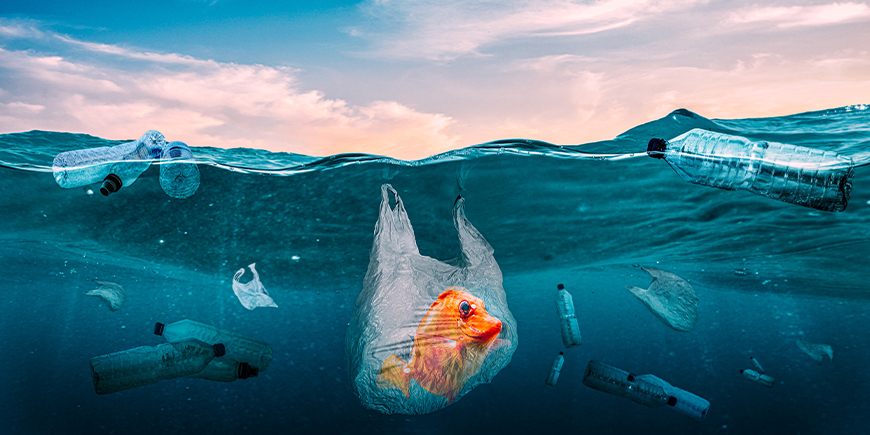The impact of microplastics in the marine environment is alarming, particularly in the Mediterranean Sea
Microplastics are becoming a hot topic. Initially denounced only by the various environmental associations, institutions and citizens are now beginning to become aware of this problem, which is poisoning the seas and oceans and the species that live in them.
Not an underestimated problem
There are now many studies proving their dangerousness and increasing presence in waters around the world.
However, a recent study by the Institute of Environmental Science and Technology of the Autonomous University of Barcelona (ICTA-UAB) has shown that microplastic pollution could be even more serious than imagined.
Microplastics
Microplastics are fragments of plastic that are virtually invisible to the naked eye and less than 5 millimetres in diameter. Because they are so small, they cannot be filtered out by water treatment systems and, due to their very long degradation times, end up in soil, rivers and oceans, where they persist in the environment.
These tiny particles can result from the breakage of larger objects or can enter the marine environment directly as granules, pellets or fibres. It is now known that microplastics can act as carriers of additive chemicals, organic and metallic pollutants accumulated from surrounding waters. Furthermore, because they are the same size as many planktonic organisms, ingestion of microplastics causes many problems for marine fauna. With easily predictable consequences for human health.
The Mediterranean: a ‘plastic soup’
The Mediterranean is one of the seas most polluted by plastic: analysis of water samples from both tourist areas and marine protected areas found levels of microplastics comparable to those found in the famous ‘plastic gyres’ of the Pacific Ocean.
Micro- and macroplastics were found almost everywhere, from the surface to the seabed and along the entire coastline. This is probably because:
- It is an enclosed sea with densely populated shores,
- Fishing is intensive,
- Shipping, tourism and industrial activities are particularly important.
The situation is further exacerbated by the limited outflow of surface water into the Atlantic Ocean.
The study
The wide variety of scientific techniques and methods used by different research teams to study microplastic pollution in the Mediterranean paradoxically limits current knowledge of this serious environmental problem that threatens our marine ecosystems.
This is the conclusion of a study carried out by a team of Catalan researchers who reviewed previous research to measure the presence of microplastics in coastal areas, deep waters and sediments of the Mediterranean Sea.
Levels of microplastics in the Mediterranean are probably higher than estimated, but currently available methods are unable to detect them.
The study notes that the methods used in laboratories to sample marine microplastics vary widely. “While this means that there have been many scientific and technological advances over the years, it also means that much of the data generated to date is not comparable,” explains Laura Simon, ICTA-UAB researcher and lead author of the study, published in the journal Environmental Pollution.
According to the research, about 82.8% of the 3,000 samples collected over the past decade were taken in coastal areas. This means that scientists have less information about the distribution of microplastics in the open ocean. Another issue is the nets used to sample surface waters: with a mesh size of around 200 microns, they are unable to capture the smallest particles.
Results and reflections
Studies to date suggest that the Mediterranean Sea contains:
- About 84,800 microplastics per square kilometre in surface waters;
- About 300 microplastics per kilogram of marine sediment;
- About 59 microplastics per kilogram of beach sand.
“The number of microplastics in the natural environment increases as their size decreases, so their levels are probably higher, but with the methods we have today we are not able to detect them,” explains Dr Patrizia Ziveri, Research Manager at ICTA-UAB.
Most plastic floats in the ocean. However, the seabed is considered the ‘ultimate dumping ground‘, the place where microplastics accumulate. There is still little information on the mechanisms by which microplastics move from surface waters to the seabed. More studies are needed to understand how plastics are able to degrade in sunlight and spread throughout the water column,’ says Dr Michael Grelaud, researcher at ICTA-UAB.
The study concludes by highlighting the importance of defining a common framework to compare results and combine methods to better characterise the wide range of plastic pollutants present in the Mediterranean and their potential impacts.
Only by working together and sharing knowledge with all stakeholders: researchers, industry representatives, citizens, will it be possible to achieve a level of awareness and active involvement in trying to curb the problem of microplastics in the sea.
Sources and Data
- Sito dell’Institut de Ciència i Tecnologia Ambientals (ICTA‑UAB): https://www.uab.cat/


